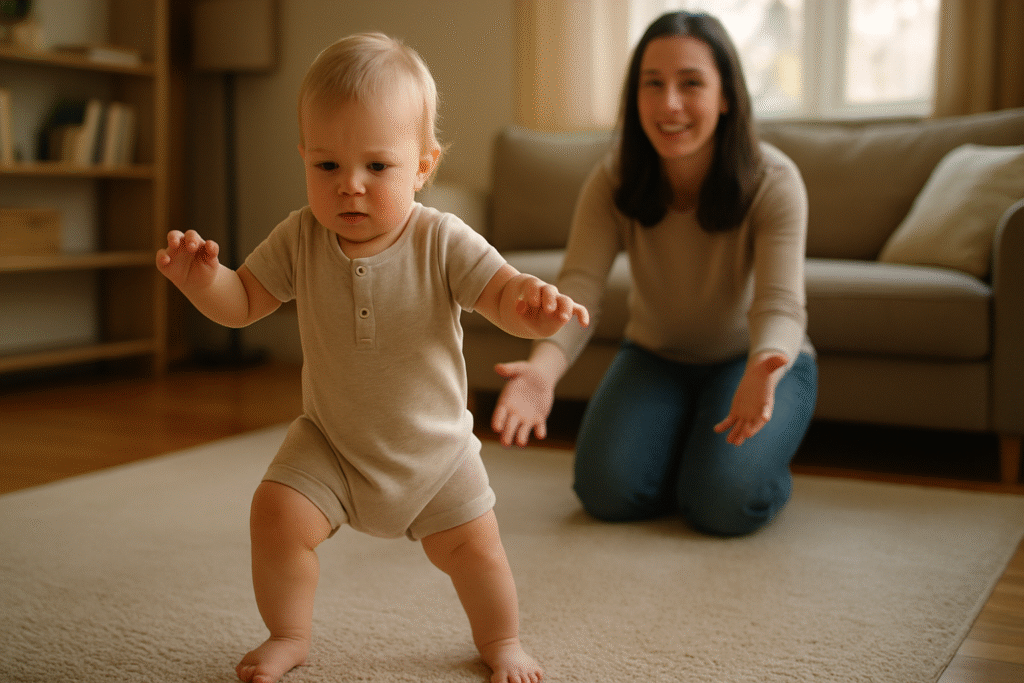
Walking is one of the most exciting milestones in a baby’s development. Between 9 and 18 months, most children begin to take their first independent steps, although the exact age can vary greatly. This journey is not just about moving from point A to point B — learning to walk means strengthening muscles, improving balance, coordinating movements, and developing confidence and independence.
Understanding how to support your baby through this stage can help make the process smoother and more enjoyable for both of you.
Walking is a complex skill that requires the coordination of multiple systems:
This explains why walking doesn’t happen overnight. Your baby practices different stages first: rolling, sitting, crawling, pulling to stand, and cruising along furniture. Each motor achievement lays the foundation for the next one.
Pure – Escargot à promener (dès 12 mois): This toy, equipped with a small xylophone on the back and antennas that move and transform into sticks to play the xylophone, will help and motivate your child to move and get around.
Why this helps with walking:
Pulling along this little snail encourages children to move around, strengthening balance and coordination. The xylophone and moving antennas add extra motivation, transforming walking into an active, playful experience.
Sensorimotor benefits:
The combination of walking and sound rewards motivates toddlers to take more steps, making walking fun and stimulating.
Tropik – Chariot de Marche Multiactivités (dès 12 mois): This toy, consisting of several parts and games, allows your child to have fun for hours without ever getting bored.
Why this helps with walking:
This activity walker provides physical support for early walkers while also keeping them engaged with multiple play options. As children push, stop, and explore, they practice balance, rhythm, and coordination — key steps toward confident walking.
Sensorimotor benefits:
By combining walking with playful exploration, this walker helps children progress naturally toward independent steps.
Porteur – Marie La Vache (dès 12 mois): This sturdy tractor is an ideal bicycle for children and for developing motor skills. In addition to being used as a bicycle, it can also be used as a support to help children learn to walk.
Why this helps with walking:
This sturdy ride-on can be used both for sitting and pushing, offering toddlers a versatile way to practice movement. It encourages them to balance, coordinate, and eventually transition from supported walking to free steps.
Sensorimotor benefits:
As children push Marie forward or ride on it, they strengthen the muscles and balance needed for walking independently.
Tacti’Basket (dès 12 mois): This basketball hoop can be hung on the wall using suction cups. Then the child can throw the three sensory balls.
Why this helps with walking:
Throwing balls into the hoop requires toddlers to stand, balance, and shift weight from one foot to the other. The playful challenge motivates them to move closer, step back, and stay active on their feet.
Sensorimotor benefits:
Tacti’Basket transforms movement into an engaging game, keeping toddlers on their feet and reinforcing essential motor skills for walking.
Every child develops at their own pace. However, consult your pediatrician if:
Remember, delays are not always a cause for alarm, but early support can make a difference.
Encouraging your baby to walk is not about rushing milestones, but about providing opportunities, safety, and encouragement. Walking is a mix of physical strength, coordination, and emotional readiness. By creating a safe environment, engaging in playful activities, and celebrating small steps, you are helping your baby move toward independence — one little step at a time.